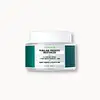What's inside
What's inside
 Key Ingredients
Key Ingredients

 Benefits
Benefits

 Concerns
Concerns

 Ingredients Side-by-side
Ingredients Side-by-side

Water
Skin ConditioningGlycerin
HumectantSqualane
EmollientDicaprylyl Ether
EmollientAluminum Starch Octenylsuccinate
AbsorbentSodium Acrylates Copolymer
Panthenol
Skin ConditioningLactobacillus Ferment
Skin ConditioningTrifolium Pratense Extract
Skin ConditioningTocopheryl Acetate
AntioxidantTocopherol
AntioxidantIsopentyldiol
HumectantCaprylyl Glycol
EmollientPhenoxyethanol
PreservativeLecithin
EmollientMaltodextrin
AbsorbentParfum
MaskingPantolactone
HumectantCitric Acid
BufferingWater, Glycerin, Squalane, Dicaprylyl Ether, Aluminum Starch Octenylsuccinate, Sodium Acrylates Copolymer, Panthenol, Lactobacillus Ferment, Trifolium Pratense Extract, Tocopheryl Acetate, Tocopherol, Isopentyldiol, Caprylyl Glycol, Phenoxyethanol, Lecithin, Maltodextrin, Parfum, Pantolactone, Citric Acid
Water
Skin ConditioningGlycerin
HumectantButylene Glycol
HumectantCyclopentasiloxane
EmollientCyclohexasiloxane
EmollientDimethicone
EmollientPropanediol
SolventPortulaca Oleracea Extract
Skin ConditioningMethyl Methacrylate Crosspolymer
PEG-9 Polydimethylsiloxyethyl Dimethicone
EmulsifyingDipropylene Glycol
HumectantUrea
BufferingLactic Acid
BufferingArginine
MaskingDimethicone/PEG-10/15 Crosspolymer
Dimethicone/Vinyl Dimethicone Crosspolymer
Skin ConditioningHydroxyacetophenone
AntioxidantFructooligosaccharides
HumectantAnhydroxylitol
HumectantXylitylglucoside
HumectantXylitol
HumectantLactobacillus Ferment Lysate
Skin ConditioningSodium Citrate
BufferingPEG-10 Dimethicone
Skin ConditioningAcetyl Glucosamine
Skin ConditioningCeramide NP
Skin ConditioningCarnosine
Skin ConditioningSodium Hyaluronate
HumectantCetearyl Dimethicone Crosspolymer
Caprylyl Glycol
EmollientMelia Azadirachta Leaf Extract
Skin ConditioningEthylhexylglycerin
Skin ConditioningSilica
AbrasiveSodium Chloride
Masking1,2-Hexanediol
Skin ConditioningMelia Azadirachta Flower Extract
Skin ConditioningDisodium EDTA
Glucose
HumectantDipotassium Glycyrrhizate
HumectantTocopherol
AntioxidantCaprylic/Capric Triglyceride
MaskingHydrogenated Lecithin
EmulsifyingPhytosteryl/Octyldodecyl Lauroyl Glutamate
Skin ConditioningWater, Glycerin, Butylene Glycol, Cyclopentasiloxane, Cyclohexasiloxane, Dimethicone, Propanediol, Portulaca Oleracea Extract, Methyl Methacrylate Crosspolymer, PEG-9 Polydimethylsiloxyethyl Dimethicone, Dipropylene Glycol, Urea, Lactic Acid, Arginine, Dimethicone/PEG-10/15 Crosspolymer, Dimethicone/Vinyl Dimethicone Crosspolymer, Hydroxyacetophenone, Fructooligosaccharides, Anhydroxylitol, Xylitylglucoside, Xylitol, Lactobacillus Ferment Lysate, Sodium Citrate, PEG-10 Dimethicone, Acetyl Glucosamine, Ceramide NP, Carnosine, Sodium Hyaluronate, Cetearyl Dimethicone Crosspolymer, Caprylyl Glycol, Melia Azadirachta Leaf Extract, Ethylhexylglycerin, Silica, Sodium Chloride, 1,2-Hexanediol, Melia Azadirachta Flower Extract, Disodium EDTA, Glucose, Dipotassium Glycyrrhizate, Tocopherol, Caprylic/Capric Triglyceride, Hydrogenated Lecithin, Phytosteryl/Octyldodecyl Lauroyl Glutamate
 Reviews
Reviews

Ingredients Explained
These ingredients are found in both products.
Ingredients higher up in an ingredient list are typically present in a larger amount.
Caprylyl Glycol is a humectant and emollient, meaning it attracts and preserves moisture.
It is a common ingredient in many products, especially those designed to hydrate skin. The primary benefits are retaining moisture, skin softening, and promoting a healthy skin barrier.
Though Caprylyl Glycol is an alcohol derived from fatty acids, it is not the kind that can dry out skin.
This ingredient is also used as a preservative to extend the life of products. It has slight antimicrobial properties.
Learn more about Caprylyl GlycolGlycerin is already naturally found in your skin. It helps moisturize and protect your skin.
A study from 2016 found glycerin to be more effective as a humectant than AHAs and hyaluronic acid.
As a humectant, it helps the skin stay hydrated by pulling moisture to your skin. The low molecular weight of glycerin allows it to pull moisture into the deeper layers of your skin.
Hydrated skin improves your skin barrier; Your skin barrier helps protect against irritants and bacteria.
Glycerin has also been found to have antimicrobial and antiviral properties. Due to these properties, glycerin is often used in wound and burn treatments.
In cosmetics, glycerin is usually derived from plants such as soybean or palm. However, it can also be sourced from animals, such as tallow or animal fat.
This ingredient is organic, colorless, odorless, and non-toxic.
Glycerin is the name for this ingredient in American English. British English uses Glycerol/Glycerine.
Learn more about GlycerinTocopherol (also known as Vitamin E) is a common antioxidant used to help protect the skin from free-radicals and strengthen the skin barrier. It's also fat soluble - this means our skin is great at absorbing it.
Vitamin E also helps keep your natural skin lipids healthy. Your lipid skin barrier naturally consists of lipids, ceramides, and fatty acids. Vitamin E offers extra protection for your skin’s lipid barrier, keeping your skin healthy and nourished.
Another benefit is a bit of UV protection. Vitamin E helps reduce the damage caused by UVB rays. (It should not replace your sunscreen). Combining it with Vitamin C can decrease sunburned cells and hyperpigmentation after UV exposure.
You might have noticed Vitamin E + C often paired together. This is because it is great at stabilizing Vitamin C. Using the two together helps increase the effectiveness of both ingredients.
There are often claims that Vitamin E can reduce/prevent scarring, but these claims haven't been confirmed by scientific research.
Learn more about TocopherolWater. It's the most common cosmetic ingredient of all. You'll usually see it at the top of ingredient lists, meaning that it makes up the largest part of the product.
So why is it so popular? Water most often acts as a solvent - this means that it helps dissolve other ingredients into the formulation.
You'll also recognize water as that liquid we all need to stay alive. If you see this, drink a glass of water. Stay hydrated!
Learn more about Water